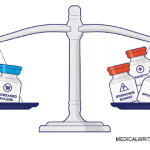
Panchenko Vladimir / shutterstock.com
AMSTERDAM—As more biosimilar drugs for rheumatic diseases make their way to market, evidence is growing that switching from the originator drug to a biosimilar tends to be effective, while the questions of switching back and forth, and switching multiple times using several different biosimilars, remain to be answered, an expert on the topic said at the EULAR: Annual European Congress of Rheumatology.
How patients respond to being switched to biosimilars—which are based on the formulations of the originally approved medications but are expected to be less expensive—is of growing interest to the rheumatology community. A biosimilar to the anti-TNF infliximab (Remicade)—known in the U.S. as infliximab-dyyb (Inflectra)—is now on the U.S. market. And other biosimilars have been approved.
Some biosimilars to the TNF-blocker adalimumab (Humira), considered the world’s best-selling drug, are expected to become available in Europe in October 2018. But the release of the biosimilars in the U.S. has been delayed until 2023 following patent lawsuits and dealmaking between adalimumab manufacturer AbbVie and the manufacturers of the two biosimilars, Amgen and Samsung.
The Evidence
Some of the evidence on switching from infliximab to its biosimilar comes from extension phases of phase 3 randomized, controlled trials, said Tore K. Kvien, MD, professor of rheumatology at the University of Oslo, Norway, and head of the Department of Rheumatology at Diakonhjemmet Hospital. One of them, PLANETAS, involved infliximab and its biosimilar, CT-P13, in ankylosing spondylitis patients.1 Another, PLANETRA, involved the same drugs in rheumatoid arthritis (RA) patients.2
“These extension trials have generally confirmed that switching is not a major concern,” Dr. Kvien said. But he emphasized that the patients enrolled tended to be biologic-naive and were randomized to receive the originator drug before the switch—so they were not patients who had been on a biologic drug for a long period of time.
DANBIO, a study that assessed results after a 2016 mandated nationwide switch in Denmark from infliximab to CT-P13, found no significant differences among disease activity measures for RA, psoriatic arthritis (PsA) or axial spondyloarthritis (SpA) patients.3
The premier study assessing switches to the infliximab biosimilar is NOR-SWITCH, which enrolled 482 patients to assess whether CT-P13 was non-inferior to the originator infliximab in disease worsening among those who were stable on infliximab treatment for at least six months. All six infliximab indications were assessed—Crohn’s disease, ulcerative colitis, SpA, RA, PsA and psoriasis.4
Researchers found no significant differences between those who had switched and those who remained on infliximab in disease worsening, remission, global assessment of disease activity, drug trough levels or anti-drug antibodies, so the biosimilar was found to be non-inferior. In an extension phase, patients who were switched from originator infliximab to CT-P13 at the start of the extension phase actually had lower levels of disease worsening than those who maintained treatment with CT-P13 throughout the extension period.
“The NOR-SWITCH trial demonstrated that switching from Remicade (infliximab) to CT-P13 was not inferior to continued treatment with the originator product, which supports that switching from the originator to CT-P13 could happen for non-medical reasons,” he said.
Dr. Kvien said data are still needed in the cases of multiple switches, which, in the real world, can sometimes be necessary.
“We are discussing now and seeking funding for a multiple switch study in Norway,” he said. “We now have access to four different infliximab molecules in Norway with rather similar prices after the last national tender. Thus, it should be feasible to do a controlled study with multiple switches between four infliximab molecules compared to stable treatment with CT-P13, which is now the standard infliximab drug in Norway. We think this study will answer some important questions regarding multiple switching, as well as switching from a biosimilar back to the originator drug. We are planning one separate study for rheumatoid arthritis and one for Crohn’s disease.”
Transition Tips
Tracy French, a clinical nurse specialist in rheumatology at University Hospitals Bristol in the United Kingdom, offered lessons from her center on how to go about transitioning patients to biosimilars.
When the transition began for switches from infliximab, etanercept (Enbrel) and rituximab (Rituxan) to their biosimilars, clinicians discussed a possible change at their next review, rather than simply switching all patients at once. Ms. French said the face-to-face conversations helped, and that patients were told they were being asked to change, not required. They were told the request was being made to save money, and that they could switch back to the originator if they had flares or side effects.
Some of the 155 total patients refused to switch at first—including 22 of the 105 etanercept patients. But in the end, all but four patients made the switch, Ms. French said. She noted that seven of the 18 patients who had switched to the infliximab biosimilar had to switch back to the originator because of loss of efficacy, and she didn’t know the reason for this high number. Four of 103 patients who had switched from etanercept to a biosimilar had to switch back to etanercept due to loss of efficacy. None of the 32 rituximab switchers had to go back for loss of efficacy.
She emphasized consistency in the conversations with patients, so they are all told the same thing, as well as having a plan for how to manage patients who decline to switch, and clarifying how to manage those patients who perceive they’ve flared.
“One of the things I’ve really recognized from this is the fear that patients have of going back to their old self before they were on a biologic,” Ms. French said. “So you really see what a difference the biologics made to a patient’s life. And then they sort of perceive a change possibly as taking that away. So it’s just about managing that anxiety, really.”
Thomas R. Collins is a freelance writer living in South Florida.
4 Tips to Enhance a Switch
- Ask, don’t tell, patients to switch.
- Explain financial incentives (lower prices).
- Offer the option to switch back to the originator in the event of flares, side effects, etc.
- Maintain consistency in how you talk to patients.
References
- Park W, Yoo DH, Miranda P, et al. Efficacy and safety of switching from reference infliximab to CT-P13 compared with maintenance of CT-P13 in ankylosing spondylitis: 102-week data from the PLANETAS extension study. Ann Rheum Dis. 2017 Feb;76(2):346–354.
- Yoo DH, Prodanovic N, Jaworski J, et al. Efficacy and safety of CT-P13 (biosimilar infliximab) in patients with rheumatoid arthritis: Comparison between switching from reference infliximab to CT-P13 and continuing CT-P13 in the PLANETRA extension study. Ann Rheum Dis. 2017 Feb;76(2):355–363.
- Glintborg B, Sørensen IJ, Loft AG, et al. A nationwide non-medical switch from originator infliximab to biosimilar CT-P13 in 802 patients with inflammatory arthritis: 1-year clinical outcomes from the DANBIO registry. Ann Rheum Dis. 2017 Aug;76(8):1426–1431.
- Jørgensen KK, Olsen IC, Goll GL, et al. Switching from originator infliximab to biosimilar CT-P13 compared with maintained treatment with originator infliximab (NOR-SWITCH): a 52-week, randomised, double-blind, non-inferiority trial. Lancet. 2017 Jun 10;389(10086):2304–2316.


